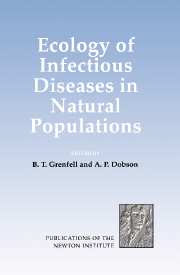Book contents
- Frontmatter
- Contents
- List of Participants
- Introduction
- BROAD PATTERNS AND PROCESSES
- PATHOGENS, INSECTS AND PLANTS
- IMPACT OF ECOLOGICAL AND GENETIC HETEROGENEITY
- Environmental Influences on Host Immunity
- Modelling the Immuno-Epidemiology of Macroparasites in Wildlife Host Populations
- Spatial Dynamics of Parasitism
- Spatial Dynamics Group Report
- Genetic Diversity in Host-Parasite Interactions
- Genetics and Evolution of Infectious Diseases in Natural Populations Group Report
- Beyond Host-Pathogen Dynamics
- Glossary
Spatial Dynamics of Parasitism
Published online by Cambridge University Press: 22 January 2010
- Frontmatter
- Contents
- List of Participants
- Introduction
- BROAD PATTERNS AND PROCESSES
- PATHOGENS, INSECTS AND PLANTS
- IMPACT OF ECOLOGICAL AND GENETIC HETEROGENEITY
- Environmental Influences on Host Immunity
- Modelling the Immuno-Epidemiology of Macroparasites in Wildlife Host Populations
- Spatial Dynamics of Parasitism
- Spatial Dynamics Group Report
- Genetic Diversity in Host-Parasite Interactions
- Genetics and Evolution of Infectious Diseases in Natural Populations Group Report
- Beyond Host-Pathogen Dynamics
- Glossary
Summary
Introduction
We consider the establishment, spread and persistence of parasitic infections in wildlife populations. In all of these, the spatial structure of the populations and their dynamics play a crucial part.
The contact structure of infections in wildlife populations is usually spatially very localised. This small scale process, where the potential interactions of an individual are often restricted to a very small number of neighbours, affects all stages of the large scale disease dynamics that we observe. We therefore need careful modelling of space, whether we are interested in the transient phenomena of establishment and spread or in steady-state phenomena such as persistence, coexistence and patterns of abundance; and whether our aim is prediction, control, or simply understanding.
We review the present state of mathematical models appropriate for parasitic diseases of wildlife, emphasizing the importance of simple models incorporating key aspects of the process in an identifiable way. Some of the issues we raise are discussed further in the group report on spatial models (Bolker et al. this volume); see also the papers by Cliff, Metz and van den Bosch, and Durrett in Mollison (1995), and, for a review from a somewhat different standpoint, Kareiva (1990).
Challenges to our present understanding include (1) The dependence of thresholds and velocities on population density, and on the spatial distribution of the contacts of an individual, and (2) Endemic patterns and related problems, such as the critical community size required to sustain a disease and its dependence on temporal and spatial scales, and the effectiveness (or otherwise) of barriers or control zones.
- Type
- Chapter
- Information
- Ecology of Infectious Diseases in Natural Populations , pp. 384 - 398Publisher: Cambridge University PressPrint publication year: 1995
- 21
- Cited by

